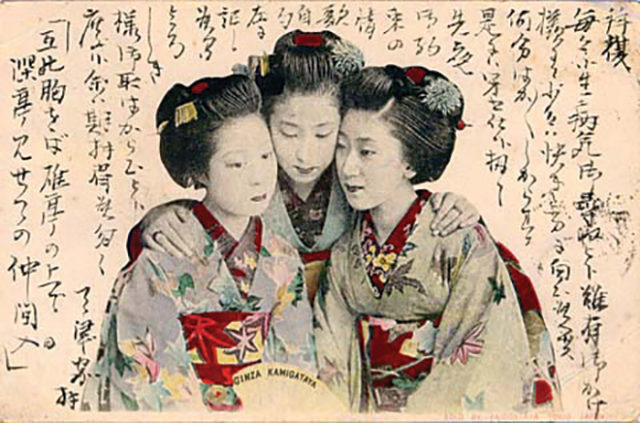By David Yamaguchi, The North American Post
NOW AND THEN, my curiosity gets the best of me. On March 23rd, I used a century-old postcard to illustrate the nearly forgotten era when Japanese prostitutes plied their trade around the Pacific Rim and American West. They were the daughters of poor farmers who were sold by their parents so that remaining family members could survive. While preparing that column, I began to wonder what is brush-stroked on the postcard. Readers too might have had their curiosity piqued.
I first approached the mystery by asking Post manager Misa Murohashi if she could transcribe the difficult to read kanji characters to Romaji, phonetic English syllables, for me.
I had to smile at Misa’s emailed reply, which was not entirely unexpected. For it is typical of working-age Japanese people today.
She wrote; “hmmmm…. Actually I cannot read that Japanese writing, as the writing form is such a[n] old way that current people never use.”
What Misa and her working-age peers face is the simplification of written Japanese that happened after World War II. A consequence of this is that young people can no longer read prewar text, whether typeset or handwritten. In this way, the Japanese are losing the ability to read their rich written history. Old writings have essentially become mere decoration to non-specialists. It is analogous to how Japanese Americans, now 3-4 generations on, are losing touch with their Japanese cultural roots. (Here, NAP Japan tour organizer Elaine Ko tells me that only half of JAs today travel to Japan. For the rest, it simply isn’t on their radar.)
Yet , there a re ordinar y people among us who can st i l l read old Japanese documents. After all, the postcard at issue is not so ancient. Its technology alone—that of hand-painted photography—places it after the US Civil War. Accordingly, I next turned to my always-smiling dance-class classmate Kiyoko Terao.

Readers may remember that Mrs. Terao came to Seattle postwar from Imabari, Ehime-ken, Shikoku, to help her sister care for a new baby. Terao-san ended up staying, as during that visit she received a marriage proposal. The key point for today’s article is that Kiyokosan attended prewar Japanese schools.
Kiyoko also demurred at first.
“Muzukashii… Samurai no kotoba mitai,” she had said. It is difficult… It is like the [antiquated] expressions of samurai.

Nonetheless, the next day, she called to say she had figured out the copy I had pressed into her hands. It is an undated note written by a man to his friend. As transcribed by Kiyoko, his long -ago words read;
“Haikei. Itsumo watashi no byouki o tazune kinishite kudasari meiwaku wo kakemashita.
“Sukoshi zutsu yoku natte orimasu ga, nakanaka omou you ni yukanaku shikatanai to omotte orimasu.
“Itsuka yakusoku shimashita jouka no juku wo hidari ni kakimashita kara, yoroshiku yoi niwa karai kudasai.
“Otagai ni [5]
omotteiru koto wo [7]
hanashiatte [5]
yuutei no naka de [7]
nakayoku shite [7],
nakama ni narimaseu.
“Chouzuke yori”
Note that above , I took the liberty to divide the poem into the 5-7-5-7-7-syllable style of Tanka to see if it fits that pattern. Its goal is to tell a complete story in 31 syllables.
As the poem has an extra line, it does not fit the standard model. Perhaps by the time it was written, Japanese poetry was already like it is now, where conveying feelings matters more than strict adherence to form. More knowledgeable readers will undoubtedly
see more into the poem’s structure than I can.
In any case, a translation might read:
“Dear Sir,
“Thank you for always inquiring about my sickness. While I am slowly improving, I think it is something that cannot be helped.
“As promised, I have written at left a verse about the women’s plight that I hope you can revise.
“To each other, Sharing our thoughts Within the teahouse, Let us become friends.
“From Chozuke”
Apparently, the postcard writer felt for the women. He believed that they helped and encouraged each other, as would most such stranded survivors in a strange land far from home.
P.S. During the two months I spent drafting this article, National Public Radio ran stories on (a) how Chinese women from rural villages are hired by wealthy men at the Beijing train station for work as mistresses; and (b) how Nigerian women are being tricked into traveling to Italy, only to find that the work available is prostitution.








